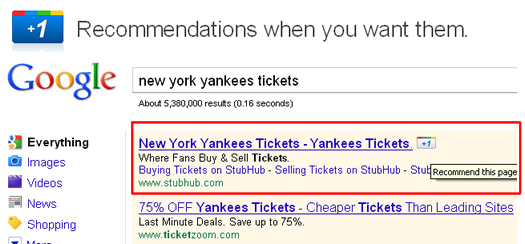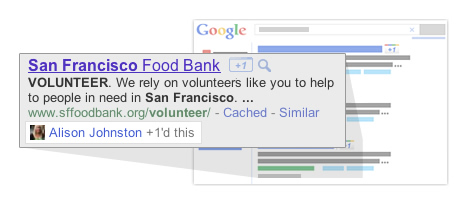
As you’ve probably heard by now, Google released its +1 social recommendation engine on Wednesday. There are several reasons Google is doing this, including trying to make search results more relevant, enabling you to recommend pages (and ads) to your social connections, and combating the Facebook Like button. At this point, your social connections are your Google contacts, but this should realistically expand to other networks as well. As I just mentioned, the +1 button is a direct shot at the Facebook Like button, which is now plastered across the entire web. Both Google and Facebook want to gather as much information from you as possible, which can then help fuel their advertising programs (which is how they make most of their money). Many people outside of Search don’t know that Google makes almost all of its money from search advertising. It’s 96%+ of its revenue. Facebook also makes most of its money via advertising, although at this stage, it’s a much smaller piece of the pie (for now).
Organic and Paid +1’s
When you +1 a page in the Google search results, the button will activate and show to your social connections. It can also show to people who aren’t part of your social connections, but only as aggregated data. For example, you might see “95 other people +1’d this page”.
Here is a screenshot showing what a +1 looks like in the organic listings:

But, this isn’t just possible for organic listings. Paid Search ads in Google can also be +1’d. More on this below, but +1’s can show up in AdWords ads when someone clicks the +1 button next to the ad, or when that page has been +1’d in the organic results. There’s an important piece to what I just explained…
If someone +1’s a page in the organic listing, and that’s the page you are using as your SEM landing page, then +1’s can show up in the ad as well.
SEM and Landing Pages
If you work heavily in Paid Search, then you probably know how powerful landing pages can be. I’m not talking about the standard webpages on a website where some marketers drop visitors. I’m referring to strategically-crafted landing pages, based on visitor intent. Visitor intent is determined by the customer segments you are targeting. Your SEM landing pages might look much different than a typically webpage, even one holding similar content. For example, you might provide stronger calls to action, rearrange content, limit navigation, etc. Remember, your goal in SEM is to convert at the highest level, since you are paying for every visitor.
In addition, dedicated SEM landing pages enable you to use split testing or multivariate testing to increase conversion. You know the traffic source, the visitor segment, etc. and you can easily limit the variables impacting your test. This is part of the reason landing pages can be so powerful. But, since SEM landing pages can contain very similar content to your organic pages, many marketers block the search engines from crawling and indexing those pages. Note, they don’t block Adsbot-Google from crawling landing pages (due to the possible impact on Quality Score), but Googlebot is blocked from indexing and caching the landing pages.
The Problem for Paid Search Marketers
Jumping back to +1’s for a second, remember that +1’s can show up in your ads when someone +1’d the ad or the landing page in the organic results. If your SEM landing pages are not being crawled or indexed, then they won’t show up in the organic results. If they don’t show up in the organic results, they can’t be +1’d. If they can’t be +1’d, then those potential +1’s can’t show up in your ads. That’s right, you might be penalized by using an advanced SEM strategy… campaign landing pages.
What About the Canonical URL Tag?
Some marketers might be using the canonical URL tag in their SEM landing pages and point back to a page on their standard site that has similar content. Until this can be tested with +1, it’s hard to say how Google will apply +1’s in ads when the canonical URL tag is being used. In theory, Google should apply landing page +1’s to the canonical URL being specified in the tag. But will +1’s at the canonical URL apply back to the landing page you are using in SEM? It shouldn’t, which would still mean problems for +1’s in your ads.
But What About +1’ing Ads?
Maybe I’m crazy, but I don’t think many people are going to start +1’ing traditional ads in AdWords. The logistics don’t even make sense. How will you know that you like the content if you are just reading the ad? You won’t. So then you’ll probably click through to a landing page (which might not indexed by Google) and you can’t +1 it (at least yet). Google will be adding +1 buttons for pages, but it’s not available yet. In addition, I’m not sure how many people are going to legitimately +1 a marketing landing page… For example, many marketing landing pages are not equivalent to a thoroughly-written how-to piece (even though it could be). More on that below.
Will Advertisers Run Ads for Organic Content?
My previous point brings up a good question. If +1’s are going to impact organic rankings (which Google said they very well could), then will advertisers try and gain more +1’s by running ads to that content. They might not be interested in the immediate conversion from that content, but the additional +1’s could possibly help the rankings of those pages. I can tell you with almost 100% certainty that this will happen if +1’s impact organic rankings. That’s unless Google adapts and flags +1’s via paid advertising versus +1’s via organic search (or other sources). Yes, this gets complex, like many other things in organic search. :)
Will Advertisers Be Punished for Using Landing Pages?
I’m confident some very smart people at Google are thinking about the paid search impact, and if advertisers will be penalized for using campaign landing pages. Most people in SEM understand that landing page testing is important. Google even has its own product to help you with multivariate and split testing (Google Website Optimizer). You would hope that Google will ensure that +1’s can help your ads, even if you are using SEM landing pages. If not, you might see some paid search marketers revert to just dropping SEM visitors on their homepage or major category pages. Then +1’s can help both organic results and paid search ads (I guess). It seems click-through rate (CTR) might be higher due to +1’s showing up in the ads, but conversion could be lower (since it’s not the most targeted content for the visitor).
In closing, this important step forward for Google Social could end up being a step backwards for AdWords advertisers. That just doesn’t seem right. Let’s hope it gets addressed soon.
GG

Glenn,
I totally see +1 being used to rank PPC. Not so much Organic. There is too much to be gamed. I think it’s a neat idea on Google’s part and hopefully it’ll hang around so we can see what it becomes. If you have a Google profile +1 is added to your profile. You can always turn of the tab so it doesn’t show publicly but neat feature. Kind of like SideWiki remember that? Only much better.
Thanks Seth. I can see how +1’s could have a positive impact on click-through rate for AdWords ads, but the problem is getting those +1’s. Like I explained in my post, I’m not sure how many people are going to +1 an ad without seeing the landing page. Then, I’m not sure how many people will +1 a marketing landing page… If you use a standard webpage on your site as your PPC landing page, then you can gain +1’s in your ad, based on +1’s coming from organic search. It’s definitely an awkward scenario right now, but I’m sure Google is working on it. :)
GG